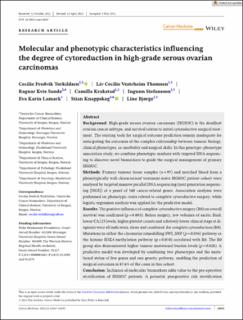| dc.contributor.author | Torkildsen, Cecilie Fredvik | |
| dc.contributor.author | Thomsen, Liv Cecilie Vestrheim | |
| dc.contributor.author | Sande, Ragnar | |
| dc.contributor.author | Krakstad, Camilla | |
| dc.contributor.author | Stefansson, Ingunn Marie | |
| dc.contributor.author | Lamark, Eva Karin | |
| dc.contributor.author | Knappskog, Stian | |
| dc.contributor.author | Bjørge, Line | |
| dc.date.accessioned | 2023-09-12T06:57:39Z | |
| dc.date.available | 2023-09-12T06:57:39Z | |
| dc.date.created | 2023-06-13T17:06:53Z | |
| dc.date.issued | 2023 | |
| dc.identifier.issn | 2045-7634 | |
| dc.identifier.uri | https://hdl.handle.net/11250/3088763 | |
| dc.description.abstract | Background: High-grade serous ovarian carcinoma (HGSOC) is the deadliest ovarian cancer subtype, and survival relates to initial cytoreductive surgical treatment. The existing tools for surgical outcome prediction remain inadequate for anticipating the outcomes of the complex relationship between tumour biology, clinical phenotypes, co-morbidity and surgical skills. In this genotype–phenotype association study, we combine phenotypic markers with targeted DNA sequencing to discover novel biomarkers to guide the surgical management of primary HGSOC.
Methods: Primary tumour tissue samples (n = 97) and matched blood from a phenotypically well-characterised treatment-naïve HGSOC patient cohort were analysed by targeted massive parallel DNA sequencing (next generation sequencing [NGS]) of a panel of 360 cancer-related genes. Association analyses were performed on phenotypic traits related to complete cytoreductive surgery, while logistic regression analysis was applied for the predictive model.
Results: The positive influence of complete cytoreductive surgery (R0) on overall survival was confirmed (p = 0.003). Before surgery, low volumes of ascitic fluid, lower CA125 levels, higher platelet counts and relatively lower clinical stage at diagnosis were all indicators, alone and combined, for complete cytoreduction (R0). Mutations in either the chromatin remodelling SWI_SNF (p = 0.036) pathway or the histone H3K4 methylation pathway (p = 0.034) correlated with R0. The R0 group also demonstrated higher tumour mutational burden levels (p = 0.028). A predictive model was developed by combining two phenotypes and the mutational status of five genes and one genetic pathway, enabling the prediction of surgical outcomes in 87.6% of the cases in this cohort.
Conclusion: Inclusion of molecular biomarkers adds value to the pre-operative stratification of HGSOC patients. A potential preoperative risk stratification model combining phenotypic traits and single-gene mutational status is suggested, but the set-up needs to be validated in larger cohorts. | en_US |
| dc.language.iso | eng | en_US |
| dc.publisher | Wiley | en_US |
| dc.rights | Navngivelse 4.0 Internasjonal | * |
| dc.rights.uri | http://creativecommons.org/licenses/by/4.0/deed.no | * |
| dc.title | Molecular and phenotypic characteristics influencing the degree of cytoreduction in high-grade serous ovarian carcinomas | en_US |
| dc.type | Journal article | en_US |
| dc.type | Peer reviewed | en_US |
| dc.description.version | publishedVersion | en_US |
| dc.rights.holder | Copyright 2023 the authors | en_US |
| cristin.ispublished | true | |
| cristin.fulltext | original | |
| cristin.qualitycode | 1 | |
| dc.identifier.doi | 10.1002/cam4.6085 | |
| dc.identifier.cristin | 2154226 | |
| dc.source.journal | Cancer Medicine | en_US |
| dc.source.pagenumber | 14183-14195 | en_US |
| dc.identifier.citation | Cancer Medicine. 2023, 12 (13), 14183-14195. | en_US |
| dc.source.volume | 12 | en_US |
| dc.source.issue | 13 | en_US |

